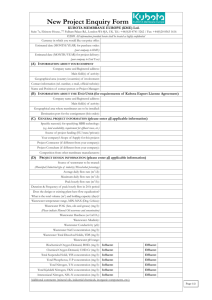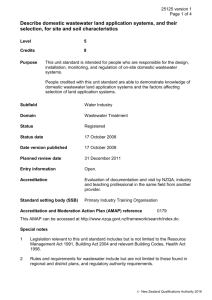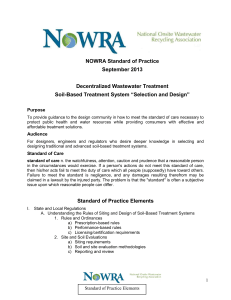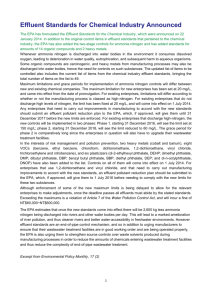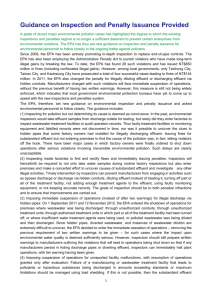BULK WASTEWATER STRATEGIC INVESTIGATION
advertisement
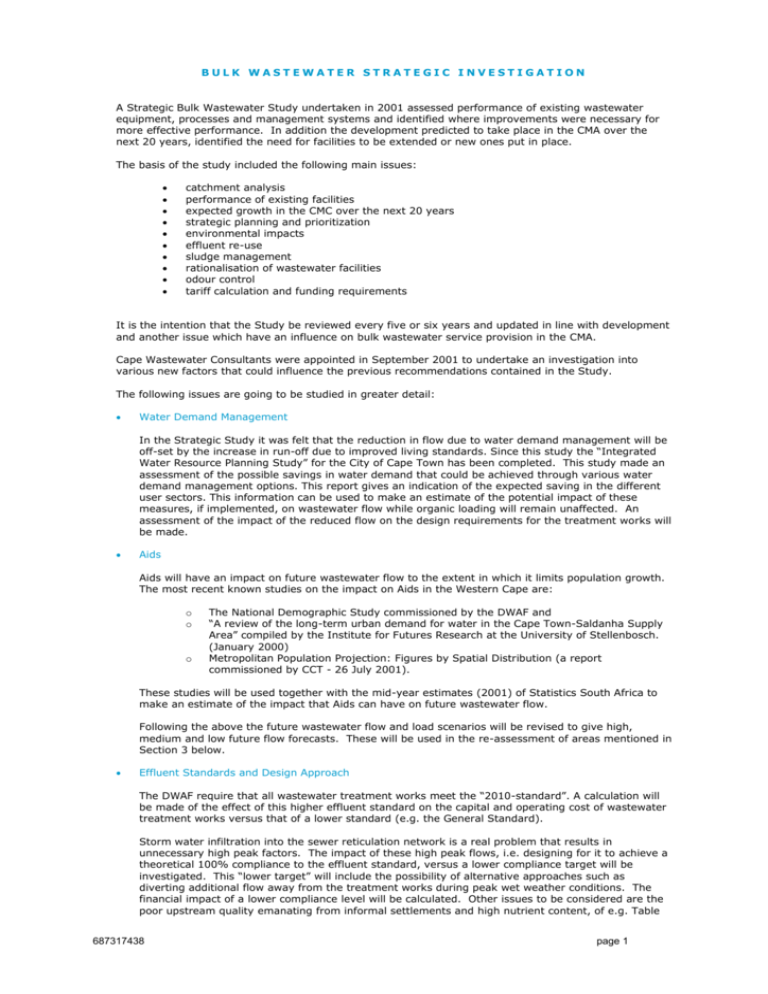
BULK WASTEWATER STRATEGIC INVESTIGATION A Strategic Bulk Wastewater Study undertaken in 2001 assessed performance of existing wastewater equipment, processes and management systems and identified where improvements were necessary for more effective performance. In addition the development predicted to take place in the CMA over the next 20 years, identified the need for facilities to be extended or new ones put in place. The basis of the study included the following main issues: catchment analysis performance of existing facilities expected growth in the CMC over the next 20 years strategic planning and prioritization environmental impacts effluent re-use sludge management rationalisation of wastewater facilities odour control tariff calculation and funding requirements It is the intention that the Study be reviewed every five or six years and updated in line with development and another issue which have an influence on bulk wastewater service provision in the CMA. Cape Wastewater Consultants were appointed in September 2001 to undertake an investigation into various new factors that could influence the previous recommendations contained in the Study. The following issues are going to be studied in greater detail: Water Demand Management In the Strategic Study it was felt that the reduction in flow due to water demand management will be off-set by the increase in run-off due to improved living standards. Since this study the “Integrated Water Resource Planning Study” for the City of Cape Town has been completed. This study made an assessment of the possible savings in water demand that could be achieved through various water demand management options. This report gives an indication of the expected saving in the different user sectors. This information can be used to make an estimate of the potential impact of these measures, if implemented, on wastewater flow while organic loading will remain unaffected. An assessment of the impact of the reduced flow on the design requirements for the treatment works will be made. Aids Aids will have an impact on future wastewater flow to the extent in which it limits population growth. The most recent known studies on the impact on Aids in the Western Cape are: o o o The National Demographic Study commissioned by the DWAF and “A review of the long-term urban demand for water in the Cape Town-Saldanha Supply Area” compiled by the Institute for Futures Research at the University of Stellenbosch. (January 2000) Metropolitan Population Projection: Figures by Spatial Distribution (a report commissioned by CCT - 26 July 2001). These studies will be used together with the mid-year estimates (2001) of Statistics South Africa to make an estimate of the impact that Aids can have on future wastewater flow. Following the above the future wastewater flow and load scenarios will be revised to give high, medium and low future flow forecasts. These will be used in the re-assessment of areas mentioned in Section 3 below. Effluent Standards and Design Approach The DWAF require that all wastewater treatment works meet the “2010-standard”. A calculation will be made of the effect of this higher effluent standard on the capital and operating cost of wastewater treatment works versus that of a lower standard (e.g. the General Standard). Storm water infiltration into the sewer reticulation network is a real problem that results in unnecessary high peak factors. The impact of these high peak flows, i.e. designing for it to achieve a theoretical 100% compliance to the effluent standard, versus a lower compliance target will be investigated. This “lower target” will include the possibility of alternative approaches such as diverting additional flow away from the treatment works during peak wet weather conditions. The financial impact of a lower compliance level will be calculated. Other issues to be considered are the poor upstream quality emanating from informal settlements and high nutrient content, of e.g. Table 687317438 page 1 Bay water, due to the upwelling phenomenon. Where appropriate reference will be made to other international policies in this regard. The allowable lower compliance level will have to be agreed with the DWAF and the Government Departments consulted by them when discharge permits are issued. In the Strategic Study work has been done by Southern Waters and the Institute for Marine Studies on the status of the freshwater and coastal environment into which treated effluent is discharged, as well as its capacity to receive more treated effluent in future. Any work on lower compliance without the input of these parties is not recommended. Provision is made for a workshop at which the above proposals will be presented before the compilation of a final position paper on the above issues. The above work will be compiled into a document reflecting the impacts of the higher standards, the input of governmental and environmental agencies and the outcome of the above process. It is envisaged that this will serve as a guiding document for design standards to be applied to all the treatment works and as a basis for further discussions with the DWAF on the relaxation of effluent standards if required. It must be realized that this is a national issue and therefore no decision could be expected from DWAF in the short term. Rationalisation The Strategic Study covered the rationalisation of treatment works in a fair amount of detail. This work was, amongst other factors, based on an assumed formula for calculating the capital cost of wastewater treatment works. Since the completion of the Strategic Study it became clear that this formula needs to be adjusted mainly due to the devaluation of the Rand and the implementation of the “2010-standard”. Depending on the outcome of the workshop on, and investigation into, effluent standards referred to above, this costing formula will be adjusted. A reassessment of this work could only be justified in view of these changes or a revision of forecast future flows. It is proposed that such a reassessment should be done for two areas only, viz. the areas incorporating the Kraaifontein and Potsdam treatment works respectively. These will include the proposed regional treatment works at Fisantekraal and the one to the north of Potsdam WWTW. These areas are chosen firstly because a final decision on the future of the works in the area is required in the near future, and since an alternative result to that obtained in the Strategic Study could still make a difference to the final decision. Only if the results of this investigation with regard to rationalisation prove to be largely different from that in the study, will it be necessary to consider re-evaluating other scenarios. The cost estimate only allows for a re-assessment of the areas given above. The output from the above will be an economic comparison of the different future development options in the respective areas. The development options to be investigated will be the most favourable options chosen from those covered in the Strategic Study and will include new regional works on greenfields sites. This will take cognizance of the opportunity cost of land. Evaluation of Capital Requirements In the Strategic Study a combination of the capital requirements for the recommended future development options for the different treatment works was used to compile an aggregate capital requirement for the whole of the area under jurisdiction of the CCT. Using the results of the revised costing formula referred to above this requirement will be adjusted to reflect the present costing structure for treatment works. It was shown that the ideal capital requirement to address the needs at the different treatment works will, at least in the initial years, exceed the financial ability of the CCT to provide for capital works. One option to balance the capital requirement and the available capital budget would be simply to distribute the proposed refurbishments and extensions over a longer time period. It will therefore be necessary that the proposed refurbishments and extensions be listed and prioritised in order to identify the work that should be executed first. The proposed refurbishments and extensions identified in the Strategic Study and updated as per the above investigation will be prioritised in consultation with CCT-staff. The outcome of this process might require that extensions cannot be implemented as envisaged and the works be extended over a longer time period. The proposed action may imply that sub-standard effluent be released into watercourses until the proposed ultimate extensions are implemented. This approach will again require approval from permitting authorities such as DWAF and DECAS. The viewpoint of the authorities as obtained at the proposed workshop referred to above will give guidance in this regard. Further specialist studies might be required to assess the impact of the lower standard effluents. No allowance has been made for such studies if required. Another option for alleviating the demand on the capital budget would be to consider alternative funding and implementation options. These might also be linked to alternative management options (e.g. BOT). Such options will be identified together with possible schemes to which it could be applied. The impact of both the redistributed capital requirements and alternative funding options on unit rates will also be calculated. The actual impact of the latter will be influenced by specific agreements on repayment and operational efficiency. Agreed assumptions on levels of repayment and operational efficiency will be used to calculate these impacts. It is specifically important that the impact of 687317438 2 page alternative funding on unit rates be determined in the medium to long term to avoid unreasonably high unit rates due to repayment of higher than normal capital investment. The outcome of this will be revised capital requirements for the two alternative options listed above with associated impact on unit rates. Estimated Planning Horizon The Strategic Study considered a planning horizon of 20 years. Questions have been raised as to the sufficiency of this horizon in considering rationalisation. This specifically relates to the economic life of civil structures. For this part of the study it is proposed to do some research on international strategies with regard to works in urban areas that have come to the end of their economic life. This will be used to create a long-term vision for Cape Town by incorporating these ideas with knowledge gained during the previous study and at local treatment works. The impact of extending the planning horizon to 50 years on the two areas identified to be investigated for rationalisation will be analysed and reported on. In view of these results a broader vision for the rest of the CMA and treatment works whose continued existence could be impacted on by the longer horizon will be given. The outcome of this work will be specific recommendations regarding the long-term future of treatment works in the Kraaifontein/Scottsdene/Fisantekraal area and the Potsdam/Vissershok/Melkbos area. Based on this a broader vision of the future of other treatment works such as Gordons Bay, Mitchells Plain, Borcherds Quarry and Athlone will be given. Infiltration With reference to discussions in this regard we confirm our notion that this issue will best be addressed through identifying a target catchment in which infiltration is a critical problem and to systematically work through this area to identify and address problem areas. It is also believed that an effective public awareness programme is a key requirement for alleviating this problem. A dedicated team should preferably be set up to deal with this specific problem. A proposal will be made on how this problem should be addressed and on the areas to be targeted. The extent to which infiltration has impacted on the design of treatment works and its impact on future planning will be addressed. 687317438 3 page


